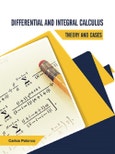Key Features:
- Complete coverage of basic calculus, including differentiation and integration
- Easy to read presentation suitable for students
- Information about functions and maps
- Case studies and exercises for practical learning, with solutions
- References for further reading
Table of Contents
Chapter 1 Real Numbers
1.1. Limitations
1.2. Algebraic Properties of the set R
1.2.1. Natural Numbers
1.2.2. Integer Numbers
1.2.3. Rational Numbers
1.2.4. Irrational Numbers
1.2.5. Open, Closed, and Half-Open Intervals
1.2.6. Absolute Value
1.2.7. Infimum and Supremum
1.3. Case Study: Absolute Value Inequalities
1.4. Case Study: Rationalization of Irrational Numbers
1.5. Case Study: Construction of Irrational Numbers
1.6. Exercises
Chapter 2 Functions and Maps
2.1. Functions
2.1.1. Domain of a Function
2.1.2. Image of a Function
2.1.3. Graph of a Function
2.2. Maps
2.2.1. Domain of a Map
2.2.2. Image of a Map
2.2.3. Graph of a Map
2.2.4. Maps R→R
2.2.5. Maps R→R2
2.3. Classification of Functions and Maps
2.3.1. Injection type
2.3.2. Surjection type
2.3.3. Bijection type
2.4. Inversion
2.5. Composition
2.6. Elementary Functions and Maps
2.6.1. Algebraic Functions and Maps
2.6.2. Linear type
2.6.3. Quadratic type
2.6.4. Rational type
2.6.5. Irrational type
2.6.6. Transcendental Functions and Maps
2.6.7. Sine type
2.6.8. Cosine type
2.6.9. Tangent type
2.6.10. Exponential type
2.6.11. Logarithmic type
2.7. Case Study: Has f (x) = x2 an Inverse?
2.8. Case Study: Expected Profit Laboratories
2.9. Case Study: Expected Profit Laboratories
2.10. Exercises
Chapter 3 Limits
3.1. Functions
3.1.1. Limit of a Function
3.1.2. Properties of Limit of Functions
3.1.3. Existence of One-sided Limits of a Function
3.1.4. Existence of Two-sided Limits of a Function
3.1.5. Important Quote on Limit of a Function
3.2. Maps
3.2.1. Limit of a Map
3.2.2. Properties of Limit of Maps
3.2.3. Existence of One-sided Limits of a Map
3.2.4. Existence of Two-sided Limits of a Map
3.3. Some Basic Limits of Functions and Maps
3.3.1. Polynomial-type
3.3.2. Trigonometric-type
3.3.3. Exponential-type
3.3.4. Logarithmic-type
3.3.5. Important Quote on Limit of a Map
3.4. Case Study: What is the Maximum area of Rectangle?
3.5. Case Study: Population Growth Estimate
3.6. Case Study: Drug Absorption
3.7. Exercises
Chapter 4 Continuity
4.1. Functions
4.1.1. Continuity of a Function
4.1.2. Properties of Continuity of a Function
4.1.3. Continuity of a Function using One-sided limits
4.1.4. Removable and Jump Discontinuities of a Function
4.1.5. Removable and Jump Discontinuities of a Function
4.2. Maps
4.2.1. Continuity of a Map
4.2.2. Properties of Continuity of a Map
4.2.3. Continuity of a Map using One-sided Limits
4.2.4. Continuity of a Map using Two-sided Limits
4.2.5. Removable and Jump Discontinuities of a Map
4.3. Weierstrass’s Theorem
4.4. Bolzano’s Theorem
4.5. Bolzano-Weierstrass’s Theorem
4.6. Case Study: Roots of a Polynomial Function
4.7. Case Study: Vertical and Horizontal Asymptotes
4.8. Case Study: Pollution Cost
4.9. Exercises
Chapter 5 Differentiation
5.1. Functions
5.1.1. Derivative of a Function
5.1.2. Continuity and Differentiability of Functions
5.1.3. Properties of Differentiation of Functions
5.1.4. Derivatives of Main Functions
5.2. Maps
5.2.1. Differentiation of a Map
5.2.2. Continuity and Differentiability of Maps
5.2.3. Properties of Differentiation of Maps
5.3. Derivative Test and Critical Points
5.4. Mean Value Theorem
5.5. L’Hospital’s Rule
5.6. Implicit Differentiation
5.7. Implicit Function Theorem
5.8. Inverse Function Theorem
5.9. The Implicit and the Inverse Function Theorems
5.10. Derivative of a Reciprocal Theorem
5.11. Case Study: Maximizing Volume
5.12. Case Study: Perimeter fence
5.13. Case Study: How Fast is the Water Level Rising?
5.14. Exercises
Chapter 6 Sequences
6.1. Arithmetic Sequences
6.1.1. Graph of sequence (an)
6.1.2. Infinite and Finite Sequences
6.1.3. Bounded and Unbounded Sequences
6.1.4. Convergent and Divergent Sequences
6.2. Properties of Limit of a Sequences
6.3. The Boundedness of Convergent Sequences Theorem
6.4. Cauchy Sequences
6.5. Sub sequences
6.6. Case Study: Term
6.7. Case Study: Term
6.8. Case Study: Term
6.9. Exercises
Chapter 7 Series
7.1. Preliminaries
7.2. Definition
7.3. Sequence of Partial sums
7.4. General Convergence Criteria
7.5. Particular Convergence Criteria
7.5.1. Series of Positive Terms
7.5.2. Alternating Series
7.5.3. Power Series
7.5.4. Telescoping Series
7.5.5. Properties of Series
7.6. Binomial Series
7.7. Taylor Series
7.8. Maclaurin Series
7.9. Case Study: Calculation of Σ∞𝒏
7.10. Case Study: Let the value e
7.11. Case Study: Areas as Limit of a Series
7.12. Exercises
Chapter 8. Sequences and Series of Functions
8.1. Preliminaries
8.2. Definition
8.2.1. Periodic Points
8.3. Pointwise and Uniform Convergence
8.3.1. Pointwise Convergence
8.3.2. Uniform Convergence
8.3.3. Monotonicity
8.3.4. Differentiation
8.4. Properties of Convergence
8.5. Series of Functions
8.6. Case Study
8.7. Case Study
8.8. Case Study
8.9. Exercises
Chapter 9 Antidifferentiation
9.1. Antiderivative
9.2. First Fundamental Theorem of Calculus
9.3. Second Fundamental Theorem of Calculus
9.4. Notation
9.5. Basic Antiderivatives Equations
9.6. Properties of Antiderivatives
9.7. Main Techniques of Antidifferentiation
9.7.1. Integration by Substitution
9.7.2. Integration by Parts
9.7.3. Trigonometric Integrals
9.7.4. Partial Fraction Decomposition
9.7.5. Improper Integration
9.8. Integration using Maps
9.9. Case Study: Average Value of a Function
9.10. Case Study: Displacement and Distance Traveled
9.11. Case Study: Fourier Series
9.12. Exercises
Chapter 10 Solutions
Further Reading
References
Subject Index
Author
- Carlos Polanco








